About Mônica Teles:
Mônica Teles of Harrisburg, PA is a Brazilian musician. In September 2020, she described to folklorist Amy Skillman that music is a huge part of everyone’s lives in Brazil. Playing the music of her native country brings Mônica great joy, and keeps her connected to her roots.
She pronounces her name MON-i-kuh TEH-luhs.
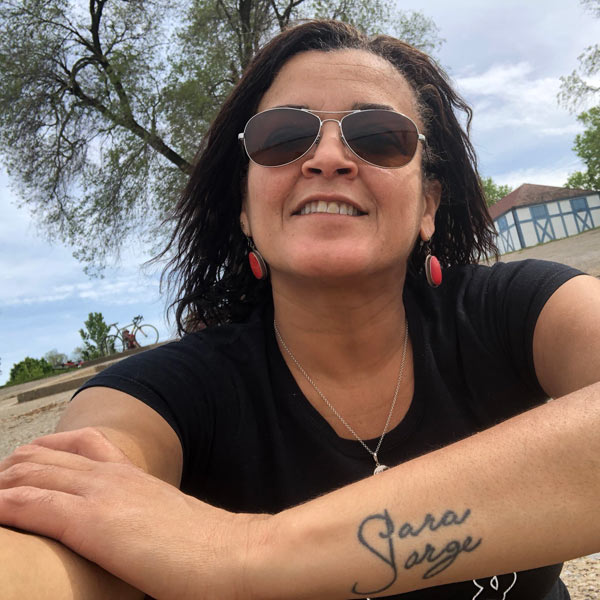
portrait of Mônica Teles courtesy of the artist
About Mônica Teles
“We breathe music in Brazil”
Mônica Teles grew up in Salvador, the capital of the state of Bahia in eastern Brazil. “We breathe music in Brazil,” she says. “We are very musical, yes, my whole household. For instance, growing up, the first person to get out of bed, the first thing to do was turn the music on... we always have music on. If we don’t have music on, our neighbors do, and we can hear them... Music is a huge part of our lives in Brazil.”
Music was even part of the games they played in the streets. “We start singing right away, and I make sure to share some of those traditions with my 10-year-old now. For instance, growing up, on my street, there was this older lady. She would ‘baptize’ all the girls’ dolls and during the baptism she would make this big pot of porridge to share with all the kids and of course we’d always be playing music. And we would practice and rehearse for Christmastime celebrations.”
The air in Salvador pulses with the rhythms of overlapping genres of music: traditional Samba, Brazilian popular music, bossa nova, axe (a-shay) with its driving drum rhythms, and forró (fu’ho), a traditional music from the Northeast region of Brazil played on accordion, a zabumba (drum) and a triangle. As the port city of the slave trade to Brazil, it is no surprise that Salvador is considered Brazil’s most African city and the “capital” of Afro-Brazilian music.
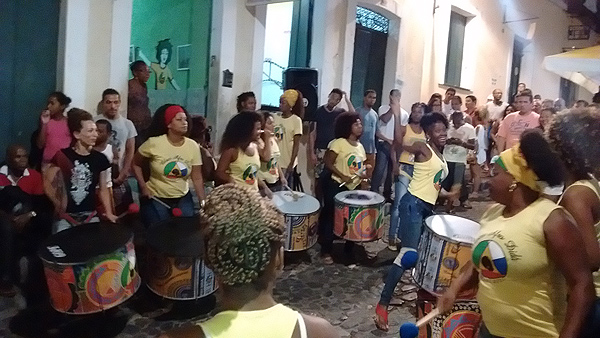
photo from Wikimedia Commons
Brazilian music also reflects the intersections of Catholic, West African, and Indigenous people’s beliefs. For instance, December 4th, St. Barbara Day, is also the celebration of Yansan (aka Yansa, Oya), the Yoruba (West African) Orisha of wind and storms. “After the celebration in the Catholic church, the celebrants would move to the streets, and drumming became a huge part of the outside celebration. Nowadays, you can sometimes hear the drums inside the Catholic churches.”
Learning by immersion
Like so many traditional artists, Mônica never had a formal teacher. She was always very observant as a child and learned from watching and being immersed in the music and the activities associated with it. Years of participation in the art form enabled her to pick it up easily, once she decided to make the effort. She says with a twinkle in her eye, “My mother says I always enjoyed being on stage and making people smile and dance.”
In fact, she says that music was the reason she decided to learn English. Both her parents were Beatles fans and she grew up listening to the Beatles. But she had no idea what they were singing about. “So, that was my motivation to learn the language.”
Coming to America
Mônica’s aptitude with English led her to become an English language teacher which, in turn, brought her to the United States where she could further develop her competency and improve her teaching skills. She first arrived in Philadelphia in 1996, but moved to Harrisburg, PA in 1997 after meeting her future husband who was from Harrisburg. They only stayed 9 months before she took him to Brazil. After two years, they came back to Harrisburg. When she returned, she started looking for musicians in the area, and that is how she started playing in earnest.
Despite years of playing music in Brazil, Mônica didn’t own a drum until she returned to Harrisburg in 2000. She jokes that back home, she just played other people’s instruments. “But my very first drum here was actually handmade by a friend. It was made of clay... which I started playing once I started visiting The Kitchen.” The Kitchen is a weekly informal gathering of musicians at the home of friends Rick and Ziza. It has been going on for nearly 30 years and features music, dance, and poetry from the Latine diaspora, including flamenco guitar and dance, among other forms. It was here that Mônica found her musical home.
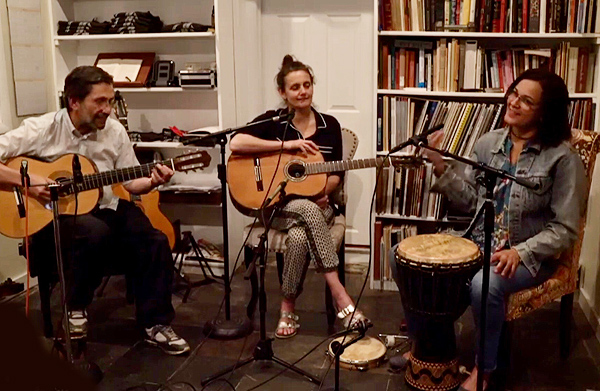
photo courtesy of the artist
Watch this virtual concert on Facebook!
Introducing Brazilian Music to Pennsylvania
Mônica considers herself primarily a singer. Bossa nova is her favorite form of Brazilian music. Bossa nova was developed and popularized in the 1950s and 1960s and is today one of the best-known Brazilian musical styles abroad. The phrase bossa nova means "new trend" or "new wave" and is a fusion of the traditional Brazilian rhythms of Samba with a harmonically complex jazz harmony and melody.
One of her favorite singers in this style is Elis Regina, who is also her mother’s favorite singer. One morning Mônica was working on a song when her mother called. She sang it for her and asked her opinion. Her mother said “Wow, you almost sound like Elis!” For Mônica, that was high praise. She has always been inspired by Elis Regina’s powerful voice. “She was a teeny tiny little person with a huge voice and her presence on stage was amazing.”
But Mônica also enjoys drumming and singing many other Brazilian musical forms. “Because of my exposure to music growing up in this little fisherman neighborhood in Brazil, with different influences, different cultures, not only African but the Indigenous cultures, I always enjoyed drumming. Drumming is what would make me dance.”
In the early 2000s, she saw the group Olodun performing samba reggae in the streets of Philadelphia and she “became contaminated with that rhythm and I told myself, I really want to play.” Olodun is a world-renowned Afro-Brazilian group from Bahia that was founded to highlight African heritage and pride through music, dance theater, and art.
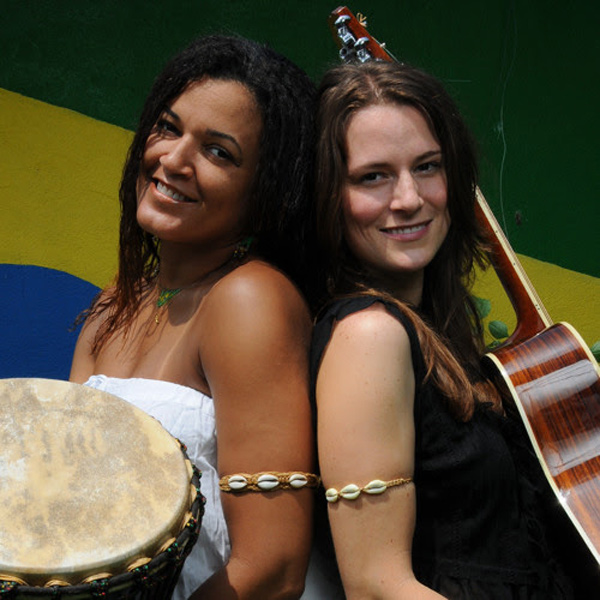
photo courtesy of the artist
“Collaboration is what I like to do.”
Mônica promotes and sustains her Brazilian heritage through collaboration with other musicians. She is captivated by opportunities to blend her rhythms and vocals with others. She currently has three different avenues for playing Brazilian music.
- Batida (pronounced ba-chee-da) which means “beat” in Portuguese, is a collaboration with Chelsea Caroline. The duo started playing together in 2006. They perform original songs as well as Brazilian and American songs. Mônica has translated some Brazilian songs into English and they perform in both English and Portuguese. Listen to Batida on SoundCloud.
- Suddenly Bossa is a trio with Flamenco guitarist John Catalano and his wife Jen. They focus on bossa nova, rhumba, and flamenco, which is an opportunity for Mônica to feature her singing. They sometimes harmonize in both English and Portuguese and can often be found playing at Rubicon in Harrisburg. Watch a virtual concert on Facebook
- Brazilian Vibes is a larger group that plays a full range of Afro-Brazilian musical forms.
Mônica notes that Central Pennsylvania has become more open to diversity. “In the early 2000s I didn’t feel as much appreciation from others for what I did, because people were not open to listening to music that they didn’t really understand. But I think that has changed a lot. I am so grateful for that.”
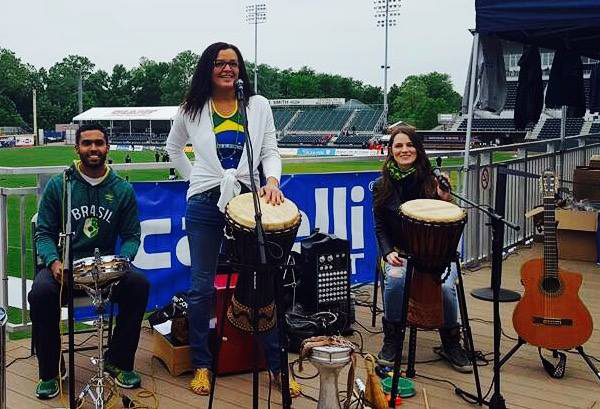
photo courtesy of the artist
“Playing music... It’s definitely my fuel.”
Mônica describes her musical community as “a vibrant and diverse group of music lovers... Those are also people that are very curious and willing to learn more.” There is a small Brazilian community in central Pennsylvania, perhaps about 100 people between Harrisburg, Lancaster, and York. She also belongs to a group of about 35 local Brazilian ladies who get together (often in someone’s backyard) for the major Brazilian holidays, such as the Festival of St. John on June 24th. They cook the traditional celebration food, decorate the space with banners and cornhusks folded into shapes, set off fireworks, “and then we just play music.”
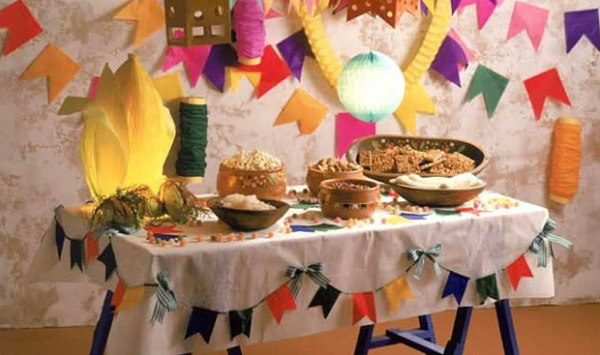
photo courtesy of the artist
“Being an educator, myself, being able to educate people on Brazilian music and Brazilian culture in general — I like to talk about the songs that I perform. So whenever I have an opportunity, whoever is interested in Brazilian culture, I actually welcome that.” She especially enjoys informing people that Brazilians speak Portuguese, not Spanish. Many do not know that about Brazil. So, for Mônica, music is also an educational tool.
And she is using the music to teach her daughter about her Brazilian heritage — not formally. She wants her daughter to enjoy it, so she simply involves her in the music, in the same way she was involved as a child. She wants her daughter to be bi-lingual and bi-cultural. Music is a big part of making that happen.



Brand icons for Facebook, YouTube, Instagram and other social media platforms are the trademark of their respective owners. No endorsement is implied.